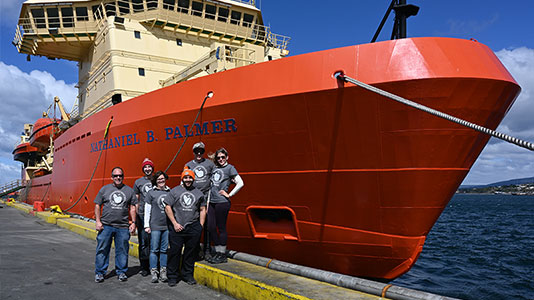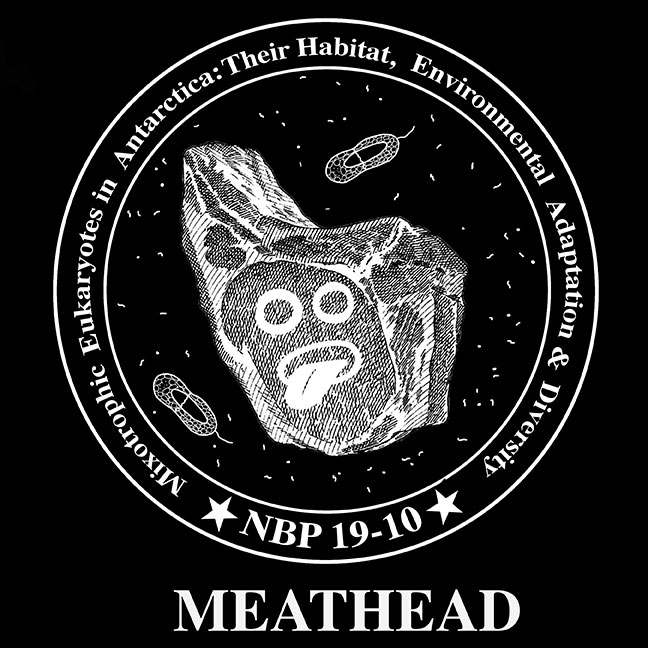Welcome to Antarctica!
November 20, 2019 | Dr. Wade Jeffrey, Director of CEDB | wjeffrey@uwf.edu

These will be field reports from our National Science Foundation-funded project on a 45-day research cruise aboard the RVIB NATHANIEL B PALMER. I encourage you to share with friends, family, and students and don’t hesitate to ask me questions. We will be working along the western side of the Antarctic Peninsula. This is the second cruise for the project (our first was in April and May). Oceanographic science projects love acronyms – we called the trip in April REMIXED which stands for Research Examining MIXotrophic Ecology and Diversity. For this cruise, with tongues firmly in cheek, we care to call the project MEATHEAD (Mixotrophic Eukaryotes in Antarctica: Their Habitat, Environmental Adaptation & Diversity). Of course, we made T-shirts with our logo on them. More about the actual science later. There are six of us on board, Robert Sanders is from Temple University and he has a post-doctoral fellow named Jean-David Grattepanche and a graduate student named Chris Carnivale with him. Nicole Millette is a postdoctoral associate at the Woods Hole Oceanographic Institute and I am joined by the University of West Florida graduate student Leila Harris. We left Punta Arenas, Chile on November 2 and have now crossed the Drake Passage and have started working in an area known as the Palmer Deep (near Palmer Station, one of the permanent US research bases in Antarctica). As usual, the port call when we set up our equipment and supplies, was pretty frantic. We were able to set up our two primary lab spaces (the “hydro lab” where most of the samples are processed, and the “Rad van” where we will use radioisotopes to measure microbial growth and production) with some extra space in the “wet lab.” The civil unrest in Chile created some travel delays for both some equipment and people and we ended up being a day late leaving port.
Besides setting up the ship for our work, we were fitted for our “Extreme Cold Weather (ECW)” gear. On this trip, this includes waterproof rain gear, GORE‑TEX® outerwear, sea boots, gloves, hats, goggles, jackets, and fleece. I bring most of my own gear that I have found over the years and that I like a lot. We did make one last-minute trip to the grocery for personal stuff (and chocolate) and another market for some holiday decorations (and a unicorn onesie… more below). On the way back to the ship we made sure to stop and “rub the toe of the Indian” at the Magellan statue in the central park in Punta Arenas. This is to ensure good luck on our voyage and a safe crossing of the Drake Passage. We also made sure to sacrifice a can of Pringles to King Neptune as we left port, also to ensure a safe and successful journey. On our last cruise, some of the people from another project had adult-sized “onesies” that I suppose are pajamas... But they were unicorn costumes. JD got one and wore it all the way across the Drake passage, again, hoping for calm seas. I guess it sort of worked. We are nothing if not superstitious.
Our general schedule has us transiting across the Drake Passage to a region known as the Palmer Deep. The first order of business is to install and set up to high-frequency radar arrays on two different islands (the third will go at Palmer Station). Each involves moving about 11,000 lbs of gear from the ship to the installation site. There is no easy way to do - it’s pretty much man-hauling from the shoreline up the hill to where the tower will be built. Once installed, these instruments can monitor surface currents in the Palmer Deep. Turns out this is a critical area for penguin foraging for a couple of nearby rookeries. Part of the project will also be looking at krill (small shrimp-like animals) in these waters (a primary food for penguins). Ten days is dedicated to this process and we will mostly stand by, helping when we can and doing a few preliminary experiments of our own. The six people involved with the array project will then leave the ship at Palmer Station and those of us remaining aboard will spend 24 days conducting our own work along the Antarctic Peninsula.
The other project that will be aboard with us will be studying sea ice algae – this is the dense microbial community that grows on the underside of sea ice. It is a critical food source for krill and may help “seed” the water column with plankton as the season progresses. We will be examining the ecology and diversity of mixotrophic phytoplankton. These single-celled organisms are phytoplankton, so they photosynthesize like plants… but they also have the ability to consume particles or what you and I would call eating. Depending on how they make their living could determine how carbon moves through the food web. Our first trip examined these organisms in late fall/early winter (when daylight was low). This trip will be looking at spring/summer samples when daylight is bright. For comparison, when we left in May, the day length was about 6 hrs, now it is 18 hrs (and will keep getting longer).
Here is a web page where you can follow our actual position:
https://www.sailwx.info/shiptrack/shipposition.phtml?call=WBP3210
Palmer sits on Anvers Island. There is Hero Inlet in front of the station on the right (named after the old wooden research vessel HERO used until the ’80s. To the left is the larger Arthur Harbor which ends at the glacier. The most remarkable thing about the change in Palmer station is the receding glacier behind it... In 1999 it came down just behind the station, now it's way up the hill. There is now an area referred to as the station “backyard” which didn’t exist when I worked there. While standing in the back of the station looking at the glacier we could hear it cracking and changing. We didn’t see any break-offs, but we sure heard a lot! One real obvious evidence of the change in the glacier is that now you can see Dietrich Island as a stand-alone piece of land – until a few years ago it was covered by the glacier.
We were back aboard the NBP by dinner and left at 8 pm. We started our transit south toward Marguerite Bay. The ice is heavy and the going is slow (more than once we have had to use the “back and ram” method to break through heavier ice. But the ship is now dedicated to our project and the sea ice team and we are excited to get into our routine.








